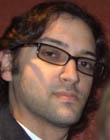|
|
 
|
|
Author
|
Topic: Poll - Digital Projection Framing - in the real world
|
|
|
|
|
|
|
|
|
Mike Olpin
Chop Chop!

Posts: 1852
From: Dallas, TX
Registered: Jan 2002
|
 posted 06-10-2010 07:04 PM
posted 06-10-2010 07:04 PM




Let me read into your intentions a little bit, I'm sorry if I missread.
The reason I think you are wondering about the charts is that a 3d object in positive space (appearing closer than the screen) cannot intersect the edge of the screen. If it does, the viewer will receive two conflicting depth cues. One cue from the stereopsis effect telling them the object is closer and the other cue from the known position of the screen relative to the viewer, telling them the object is at the same depth as the screen itself. This might be a contributing factor to discomfort and headaches some people associate with 3D.
Unfortunately, I believe a large percentage, at least half, of digital screens are over cropping slightly. A lot of screens have a slight curve. Some auditoriums were built with incorect aspect ratios, and the owners didn't care to fix them when the transition to digital occured.
I would recommend that a positive 3D object be treated the same as titles or other important compositional elements. Give it a "safe area". Make a rule that no object within 3 percent of the screens edge should ever enter positive space. That should keep you safe for most theaters.
Also as a side note, most of the day to day projectionists at theaters do not have the training or the tools to make changes to the DCinema image, and as a result, almost never run the included charts.
| IP: Logged
|
|
|
|
|
|
All times are Central (GMT -6:00)
|
|
Powered by Infopop Corporation
UBB.classicTM
6.3.1.2
The Film-Tech Forums are designed for various members related to the cinema industry to express their opinions, viewpoints and testimonials on various products, services and events based upon speculation, personal knowledge and factual information through use, therefore all views represented here allow no liability upon the publishers of this web site and the owners of said views assume no liability for any ill will resulting from these postings. The posts made here are for educational as well as entertainment purposes and as such anyone viewing this portion of the website must accept these views as statements of the author of that opinion
and agrees to release the authors from any and all liability.
|

 Home
Home
 Products
Products
 Store
Store
 Forum
Forum
 Warehouse
Warehouse
 Contact Us
Contact Us




 Printer-friendly view of this topic
Printer-friendly view of this topic





 where users can remain anonymous. Personal and company names will not be used in my findings. It is for personal research only into creating better 3D content.)
where users can remain anonymous. Personal and company names will not be used in my findings. It is for personal research only into creating better 3D content.)




